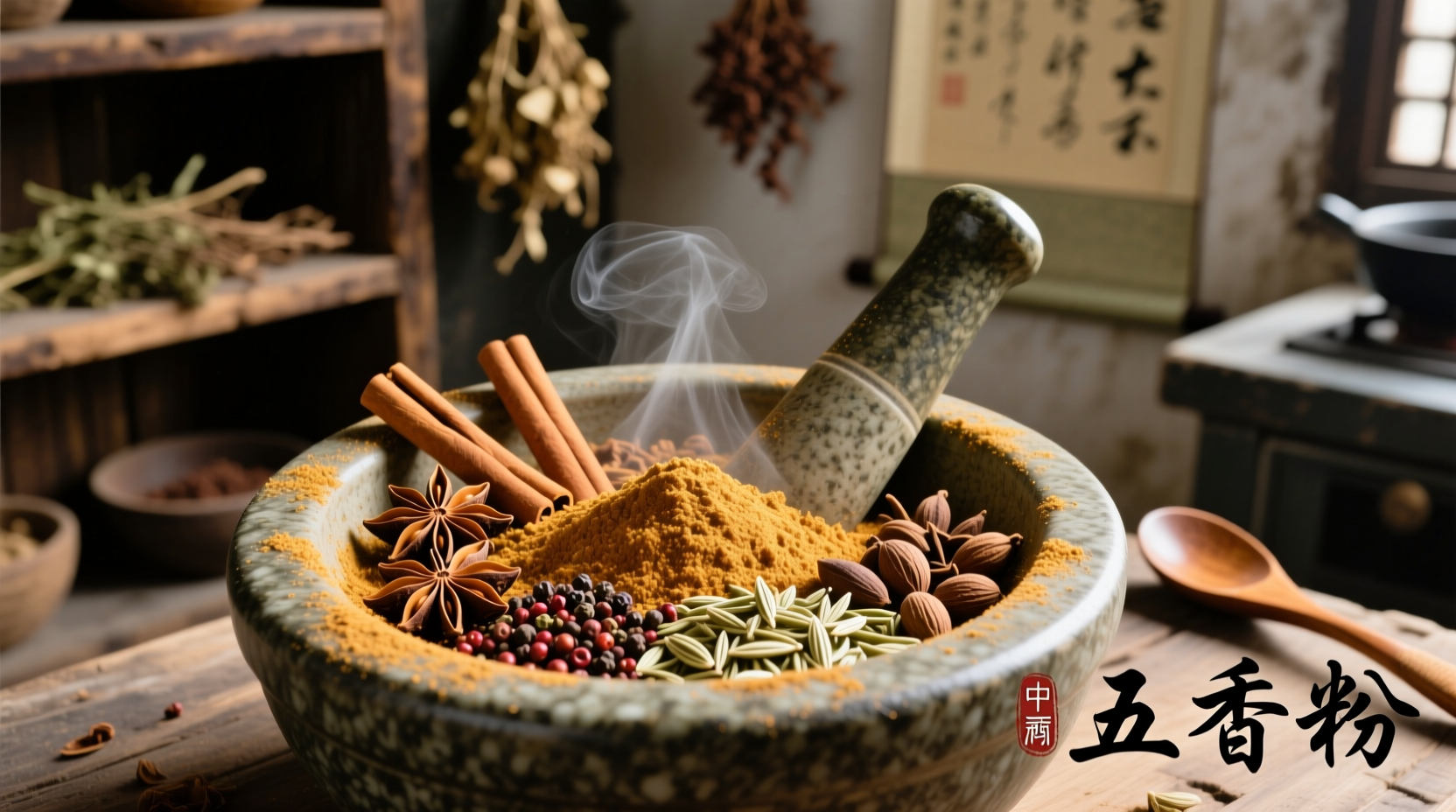The Core Components: What Exactly Makes Up Chinese Five-Spice?
Chinese five-spice powder isn't arbitrary—it's a carefully calibrated blend representing the five fundamental flavors in Chinese culinary tradition. Each component serves a specific purpose in creating balance:
- Star anise (80%) - Provides the dominant sweet-licorice note and distinctive aroma
- Cloves (10%) - Contributes warm, pungent sweetness with subtle bitterness
- Chinese cinnamon (5%) - Adds warm, woody sweetness (different from common cinnamon)
- Sichuan peppercorns (3%) - Delivers the characteristic "ma" numbing sensation
- Fennel seeds (2%) - Brings earthy, slightly sweet undertones

Why These Five Spices? The Flavor Science Behind the Blend
The precise ratio matters more than many realize. Traditional Chinese culinary philosophy seeks harmony between five fundamental elements, each spice representing one:
| Spice | Represents | Flavor Contribution | Chemical Compound |
|---|---|---|---|
| Star anise | Sweet | Licorice-like, warm | Anethole (80-90%) |
| Cloves | Bitter | Pungent, warm | Eugenol (70-90%) |
| Chinese cinnamon | Sour | Woody, sweet | Cinnamaldehyde (50-90%) |
| Sichuan peppercorns | Salty | Numbing "ma" sensation | Hydroxy-alpha sanshool |
| Fennel seeds | Umami | Earthy, sweet | Anethole, fenchone |
This chemical synergy creates what food scientists call "flavor layering"—where the combined effect exceeds the sum of individual components. The hydroxy-alpha sanshool in Sichuan peppercorns actually stimulates different nerve receptors than capsaicin in chili peppers, creating that distinctive tingling sensation without heat.
Historical Evolution: How Chinese Five-Spice Developed Over Centuries
Understanding the timeline helps appreciate why these specific spices were chosen:
- Tang Dynasty (618-907 CE): Early spice combinations emerged as the Silk Road expanded ingredient access
- Song Dynasty (960-1279 CE): First documented use of five-spice principles in culinary texts
- Ming Dynasty (1368-1644 CE): Standardized blend appears in Compendium of Materia Medica for both culinary and medicinal use
- Qing Dynasty (1644-1912 CE): Regional variations developed across China's provinces
- 20th Century: Global spread through Chinese diaspora communities
According to research from the Chinese Academy of Culinary Arts, the blend's formulation was heavily influenced by Traditional Chinese Medicine principles, where each spice corresponded to specific organ systems and seasonal needs.
Practical Applications: When and How to Use Chinese Five-Spice Effectively
Knowing what's in Chinese five-spice is only half the battle—you need to understand proper usage:
Ideal Applications
- Braising liquids for meats (especially pork and duck)
- Rub for roasted Peking duck
- Marinades for char siu (barbecue pork)
- Flavor base for soups and broths
- Spice crust for roasted vegetables
Contextual Limitations
- Avoid in delicate seafood dishes - Overpowers subtle flavors
- Don't use in dairy-based sauces - Creates unpleasant chemical reactions
- Limited effectiveness in cold preparations - Heat activates essential oils
- Not suitable for desserts - Traditional blend lacks sweetness balance for sweets
Chef Liu Wei, master of Chinese regional cuisines, notes: "The magic happens when you bloom the spices in oil first—this releases the volatile compounds that create the complex aroma profile. Never add five-spice directly to cold ingredients."
Regional Variations Across China
While the core blend remains consistent, regional adaptations reflect local preferences:
| Region | Variation | Primary Use | Distinguishing Feature |
|---|---|---|---|
| Cantonese | Standard blend | Roasted meats | Higher star anise content |
| Sichuan | "Ma la" variation | Spicy dishes | Extra Sichuan peppercorns + chili |
| Hunan | "Hot five-spice" | Preserved foods | Added dried chilies |
| Fujian | "Seafood five-spice" | Seafood dishes | Reduced cloves, added ginger |
Creating Authentic Flavor: Professional Techniques
Home cooks often make these critical mistakes with Chinese five-spice:
- Using pre-ground blend exclusively - Freshly toasted and ground spices provide dramatically better flavor
- Adding at the wrong cooking stage - Should be bloomed early to infuse oils
- Overusing the blend - 1 teaspoon per pound of meat is typically sufficient
- Storing improperly - Loses potency within 3-4 months in typical containers
For best results, toast whole spices in a dry pan over medium-low heat for 2-3 minutes until fragrant, then grind fresh. Store in an airtight container away from light. The University of California's Food Science Department confirms that proper storage extends shelf life by 60% compared to standard spice jars.
Common Substitutions and Alternatives
When you don't have authentic Chinese five-spice:
- Basic substitute: 2 parts star anise, 1 part cloves, 1 part cinnamon, pinch of fennel
- For Sichuan peppercorns shortage: Add black pepper + touch of citrus zest
- Western approximation: Allspice (contains similar flavor compounds but lacks complexity)
- Vegetarian alternative: Double fennel seeds, add shiitake powder for umami
Remember that substitutes won't replicate the authentic numbing sensation—that's unique to genuine Sichuan peppercorns. The distinctive "ma la" sensation comes from hydroxy-alpha sanshool activating different nerve receptors than capsaicin.
Frequently Asked Questions
Does Chinese five-spice always contain exactly five spices?
Traditional Chinese five-spice contains exactly five components representing the five fundamental flavors. Some commercial blends add additional spices like ginger or licorice root, but purists consider these non-authentic variations.
Is Chinese five-spice supposed to be spicy hot?
No, authentic Chinese five-spice isn't hot like chili peppers. The "spice" refers to the blend's complexity. The Sichuan peppercorns create a numbing sensation (ma la), not heat. If your blend is hot, it likely contains added chili peppers.
Can I make Chinese five-spice without Sichuan peppercorns?
You can create a substitute, but it won't be authentic Chinese five-spice. Sichuan peppercorns provide the essential "ma" numbing sensation that defines the blend. Without them, you're making a different spice mixture entirely. For closest approximation, use black pepper plus a touch of citrus zest.
How long does homemade Chinese five-spice last?
Properly stored in an airtight container away from light and heat, homemade Chinese five-spice retains optimal flavor for 3-4 months. Whole spices stored separately last 6-12 months. The University of California Food Science Department confirms that vacuum-sealed storage extends freshness by 60% compared to standard containers.











 浙公网安备
33010002000092号
浙公网安备
33010002000092号 浙B2-20120091-4
浙B2-20120091-4